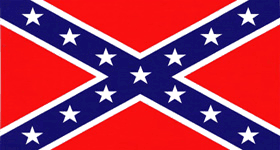 |
Civil War Battles |
|
State War Records |
| AL - AK - AZ - AR - CA - CO - CT - DE - FL - GA - HI - ID - IL - IN - IA - KS - KY - LA - MA - MD - ME - MI - MN - MS - MO - MT - NE - NV - NH - NJ - NM - NY - NC - ND - OH - OK - OR - PA - RI - SC - SD - TN - TX - UT - VT - VA - WA - WV - WI - WY |
The Battle of Fort Sumter
April 7, 1863 in Charleston, South Carolina
 |
|||||||||||||||||||||
|
Determined to capture Charleston in April, Rear Adm. Samuel F. DuPont assembled a flotilla of 7 moniters- the most powerful, irresistible warships afloat- plus the ironclads Keokuk and New Ironsides. Each packed a punch as heavy as anything then seen in American warfare, with 1 11-inch and 1 15-inch cannon. Hunter prepared his land forces on Folly, Cole's, and North Edisto Islands to cooperate with a naval bombardment of Fort Sumter.
DuPont launched his attack, the South Atlantic Squadron, at noon on the 7th and was met by 77 Confederate guns opening fire as the ships ran afoul of the harbor's torpedoes (mines) and obstructions. The moniters' guns brought great chuncks of Fort Sumter's masonry sliding into the harbor, but the return fire from the shore batteriers was even more destructive. Confederate gunners struck the little ships over 400 times, and when a solid shot hit true, it jarred the entire vessel, shaking turrents from their tracks and jamming them. Decks were pierced, armor ripped up, smokestacks shredded, and guns knocked out of commision. The Keokuk was shot to pieces with over 90 hits, the Weehawken was hit 53 times, the Nahant 51 times. The entire flotilla hit Fort Sumter with only 55 shots in return. The attack had little impact on the Confederate defenses of Charleston Harbor. Although several of Hunter's units had embarked on transports, the infantry were not landed, and the joint operation was abandoned.
As evening came, DuPont signaled a withdrawal. Though he intended to renew the battle the next morning, a look at his ships and reports from his captains dissuaded him. The Keokuk sank during the night, and the rest of the moniters were heavily damaged. The guns of Charleston had proved a match for the feared moniters. DuPont lost his command for the failure, and the Union army and navy turned to other means to try to take Charleston.
The ironclad warships Keokuk, Weehawken, Passaic, Montauk, Patapsco, New Ironsides, Catskill, Nantucket, and Nahant participated in the bombardment.
